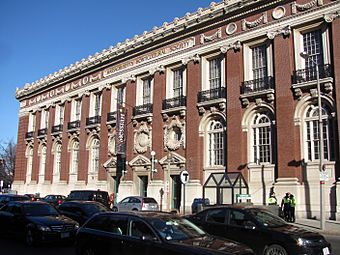Symphony and Horticultural Halls facts for kids
Quick facts for kids |
|
|
Symphony and Horticultural Halls
|
|

Horticultural Hall
|
|
| Location | Boston, Massachusetts |
|---|---|
| Built | 1900 |
| Architect | McKim, Mead & White; Wheelwright & Haven |
| Architectural style | Late 19th And 20th Century Revivals |
| NRHP reference No. | 75000301 |
| Added to NRHP | May 30, 1975 |
The Symphony and Horticultural Halls are two important old buildings in Boston, Massachusetts. You can find them at the corner of Massachusetts and Huntington Avenues. These buildings are special because they show how Boston grew and changed over time.
Both halls were added to the National Register of Historic Places in 1975. This list helps protect places that are important to history. Symphony Hall was even named a National Historic Landmark in 1999. This means it's one of the most important historic places in the whole country!
Contents
What is Symphony Hall?
Symphony Hall is a big, rectangular building where music concerts happen. It was designed by famous architects named McKim, Mead and White. The building was finished in 1900 for the Boston Symphony Orchestra.
How was Symphony Hall Built?
This grand building sits on thousands of wooden poles. These poles are stuck deep into the ground. Symphony Hall was one of the first buildings in Boston to use a steel frame. It has a brick outside with nice limestone decorations.
The main door you see today on Massachusetts Avenue was once for horse-drawn carriages. The original main entrance was actually on Huntington Avenue. It had a fancy front with columns.
What is Horticultural Hall?
Horticultural Hall was designed by Wheelwright and Haven. It was finished in 1901, just one year after Symphony Hall. This building is two stories tall. It is made of brick and stone in a style called Beaux Arts.
What was Horticultural Hall Used For?
The Massachusetts Horticultural Society built Horticultural Hall. This group started way back in 1832. The building used to have their offices. It also had rooms for talks and plant shows.
Today, Horticultural Hall is still busy. It holds offices for Boston magazine. The Handel and Haydn Society, a music group, also has offices there.
Why are These Buildings Important Together?
These two buildings are great examples of a big change in Boston. In the late 1800s and early 1900s, many cultural groups moved. They left the busy city center for new, bigger spots in the Back Bay area.
How Boston's Back Bay Area Grew
The area where these halls were built was once just muddy land. It was covered by the ocean's tides until the 1880s. By the 1850s, it had become a very smelly swampy area. So, people decided to fill it in with dirt. This created new land for building over 30 years.
Before the Symphony and Horticultural Halls, other big groups moved here. These included the First Church of Christ, Scientist and the Massachusetts Charitable Mechanic Association. They built new places along Huntington Avenue.
Later, more groups came. The New England Conservatory, the Boston Opera House, and the Boston Museum of Fine Arts all built nearby. Sadly, the opera house and Mechanics Hall were torn down in the 1950s.
The Symphony and Horticultural Halls are the most special pair of buildings left from this time of growth. They show how Boston changed and became a center for culture and arts.




